2007 ISUZU KB P190 IMMOBILISER
[x] Cancel search: IMMOBILISERPage 3307 of 6020
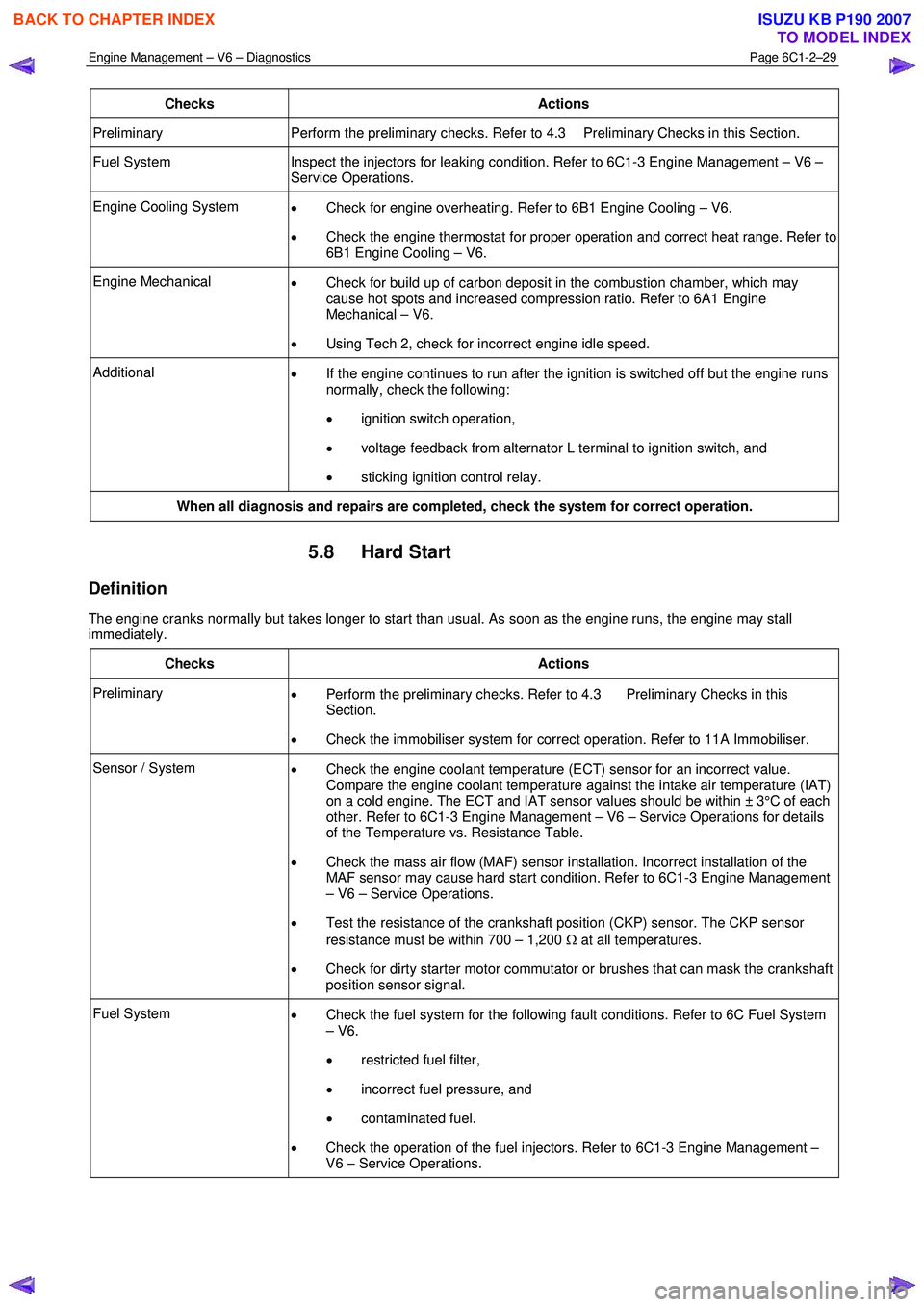
Engine Management – V6 – Diagnostics Page 6C1-2–29
Checks Actions
Preliminary Perform the preliminary checks. Refer to 4.3 Preliminary Checks in this Section.
Fuel System Inspect the injectors for leaking condition. Refer to 6C1-3 Engine Management – V6 –
Service Operations.
Engine Cooling System • Check for engine overheating. Refer to 6B1 Engine Cooling – V6.
• Check the engine thermostat for proper operation and correct heat range. Refer to
6B1 Engine Cooling – V6.
Engine Mechanical • Check for build up of carbon deposit in the combustion chamber, which may
cause hot spots and increased compression ratio. Refer to 6A1 Engine
Mechanical – V6.
• Using Tech 2, check for incorrect engine idle speed.
Additional
• If the engine continues to run after the ignition is switched off but the engine runs
normally, check the following:
• ignition switch operation,
• voltage feedback from alternator L terminal to ignition switch, and
• sticking ignition control relay.
When all diagnosis and repairs are completed, check the system for correct operation.
5.8 Hard Start
Definition
The engine cranks normally but takes longer to start than usual. As soon as the engine runs, the engine may stall
immediately.
Checks Actions
Preliminary • Perform the preliminary checks. Refer to 4.3 Preliminary Checks in this
Section.
• Check the immobiliser system for correct operation. Refer to 11A Immobiliser.
Sensor / System
• Check the engine coolant temperature (ECT) sensor for an incorrect value.
Compare the engine coolant temperature against the intake air temperature (IAT)
on a cold engine. The ECT and IAT sensor values should be within ± 3°C of each
other. Refer to 6C1-3 Engine Management – V6 – Service Operations for details
of the Temperature vs. Resistance Table.
• Check the mass air flow (MAF) sensor installation. Incorrect installation of the
MAF sensor may cause hard start condition. Refer to 6C1-3 Engine Management
– V6 – Service Operations.
• Test the resistance of the crankshaft position (CKP) sensor. The CKP sensor
resistance must be within 700 – 1,200 Ω at all temperatures.
• Check for dirty starter motor commutator or brushes that can mask the crankshaft
position sensor signal.
Fuel System • Check the fuel system for the following fault conditions. Refer to 6C Fuel System
– V6.
• restricted fuel filter,
• incorrect fuel pressure, and
• contaminated fuel.
• Check the operation of the fuel injectors. Refer to 6C1-3 Engine Management –
V6 – Service Operations.
BACK TO CHAPTER INDEX
TO MODEL INDEX
ISUZU KB P190 2007
Page 3334 of 6020
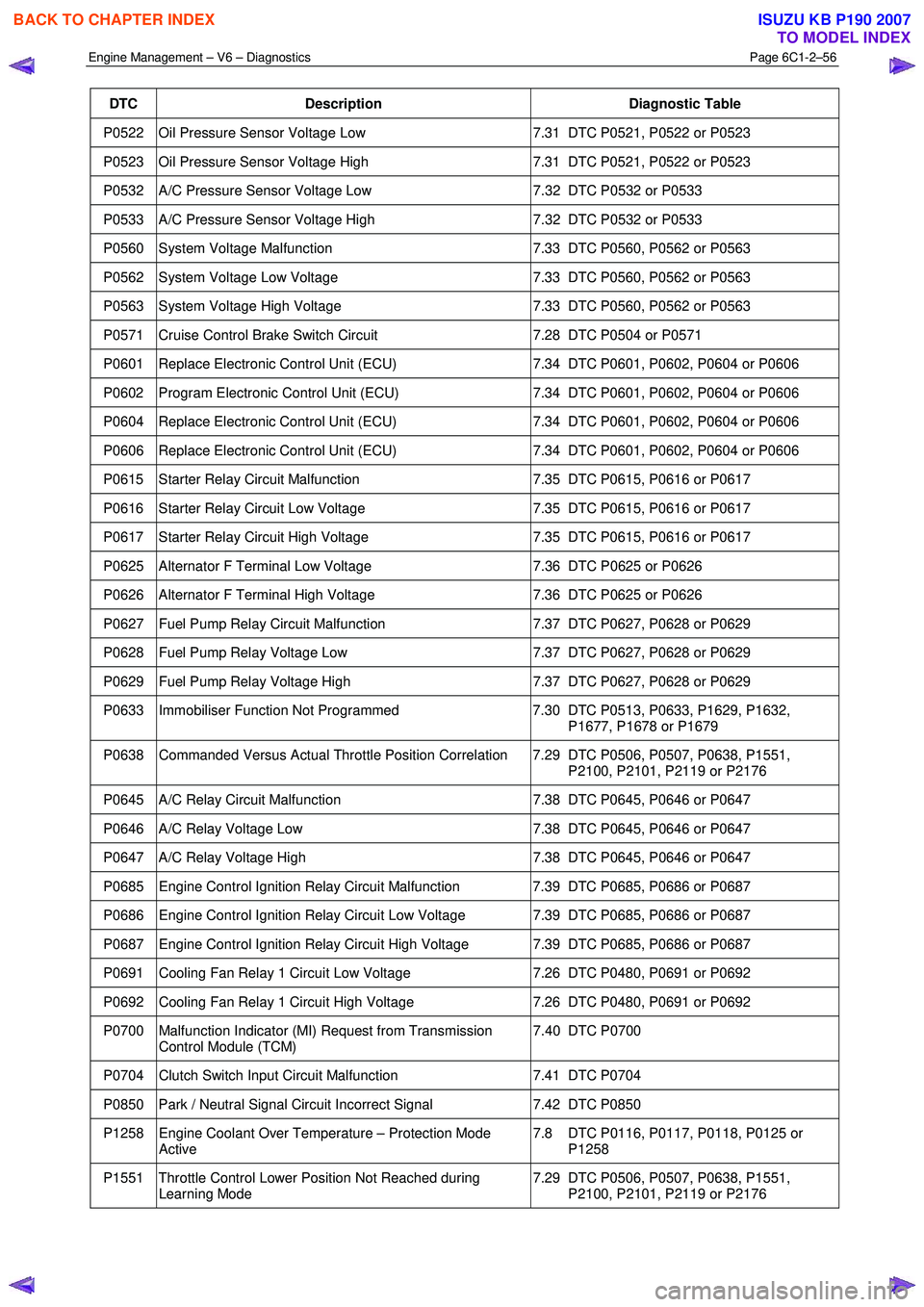
Engine Management – V6 – Diagnostics Page 6C1-2–56
DTC Description Diagnostic Table
P0522 Oil Pressure Sensor Voltage Low 7.31 DTC P0521, P0522 or P0523
P0523 Oil Pressure Sensor Voltage High 7.31 DTC P0521, P0522 or P0523
P0532 A/C Pressure Sensor Voltage Low 7.32 DTC P0532 or P0533
P0533 A/C Pressure Sensor Voltage High 7.32 DTC P0532 or P0533
P0560 System Voltage Malfunction 7.33 DTC P0560, P0562 or P0563
P0562 System Voltage Low Voltage 7.33 DTC P0560, P0562 or P0563
P0563 System Voltage High Voltage 7.33 DTC P0560, P0562 or P0563
P0571 Cruise Control Brake Switch Circuit 7.28 DTC P0504 or P0571
P0601 Replace Electronic Control Unit (ECU) 7.34 DTC P0601, P0602, P0604 or P0606
P0602 Program Electronic Control Unit (ECU) 7.34 DTC P0601, P0602, P0604 or P0606
P0604 Replace Electronic Control Unit (ECU) 7.34 DTC P0601, P0602, P0604 or P0606
P0606 Replace Electronic Control Unit (ECU) 7.34 DTC P0601, P0602, P0604 or P0606
P0615 Starter Relay Circuit Malfunction 7.35 DTC P0615, P0616 or P0617
P0616 Starter Relay Circuit Low Voltage 7.35 DTC P0615, P0616 or P0617
P0617 Starter Relay Circuit High Voltage 7.35 DTC P0615, P0616 or P0617
P0625 Alternator F Terminal Low Voltage 7.36 DTC P0625 or P0626
P0626 Alternator F Terminal High Voltage 7.36 DTC P0625 or P0626
P0627 Fuel Pump Relay Circuit Malfunction 7.37 DTC P0627, P0628 or P0629
P0628 Fuel Pump Relay Voltage Low 7.37 DTC P0627, P0628 or P0629
P0629 Fuel Pump Relay Voltage High 7.37 DTC P0627, P0628 or P0629
P0633 Immobiliser Function Not Programmed 7.30 DTC P0513, P0633, P1629, P1632,
P1677, P1678 or P1679
P0638 Commanded Versus Actual Throttle Position Correlation 7.29 DTC P0506, P0507, P0638, P1551, P2100, P2101, P2119 or P2176
P0645 A/C Relay Circuit Malfunction 7.38 DTC P0645, P0646 or P0647
P0646 A/C Relay Voltage Low 7.38 DTC P0645, P0646 or P0647
P0647 A/C Relay Voltage High 7.38 DTC P0645, P0646 or P0647
P0685 Engine Control Ignition Relay Circuit Malfunction 7.39 DTC P0685, P0686 or P0687
P0686 Engine Control Ignition Relay Circuit Low Voltage 7.39 DTC P0685, P0686 or P0687
P0687 Engine Control Ignition Relay Circuit High Voltage 7.39 DTC P0685, P0686 or P0687
P0691 Cooling Fan Relay 1 Circuit Low Voltage 7.26 DTC P0480, P0691 or P0692
P0692 Cooling Fan Relay 1 Circuit High Voltage 7.26 DTC P0480, P0691 or P0692
P0700 Malfunction Indicator (MI) Request from Transmission
Control Module (TCM) 7.40 DTC P0700
P0704 Clutch Switch Input Circuit Malfunction
7.41 DTC P0704
P0850 Park / Neutral Signal Circuit Incorrect Signal 7.42 DTC P0850
P1258 Engine Coolant Over Temperature – Protection Mode
Active 7.8 DTC P0116, P0117, P0118, P0125 or
P1258
P1551 Throttle Control Lower Position Not Reached during Learning Mode 7.29 DTC P0506, P0507, P0638, P1551,
P2100, P2101, P2119 or P2176
BACK TO CHAPTER INDEX
TO MODEL INDEX
ISUZU KB P190 2007
Page 3335 of 6020
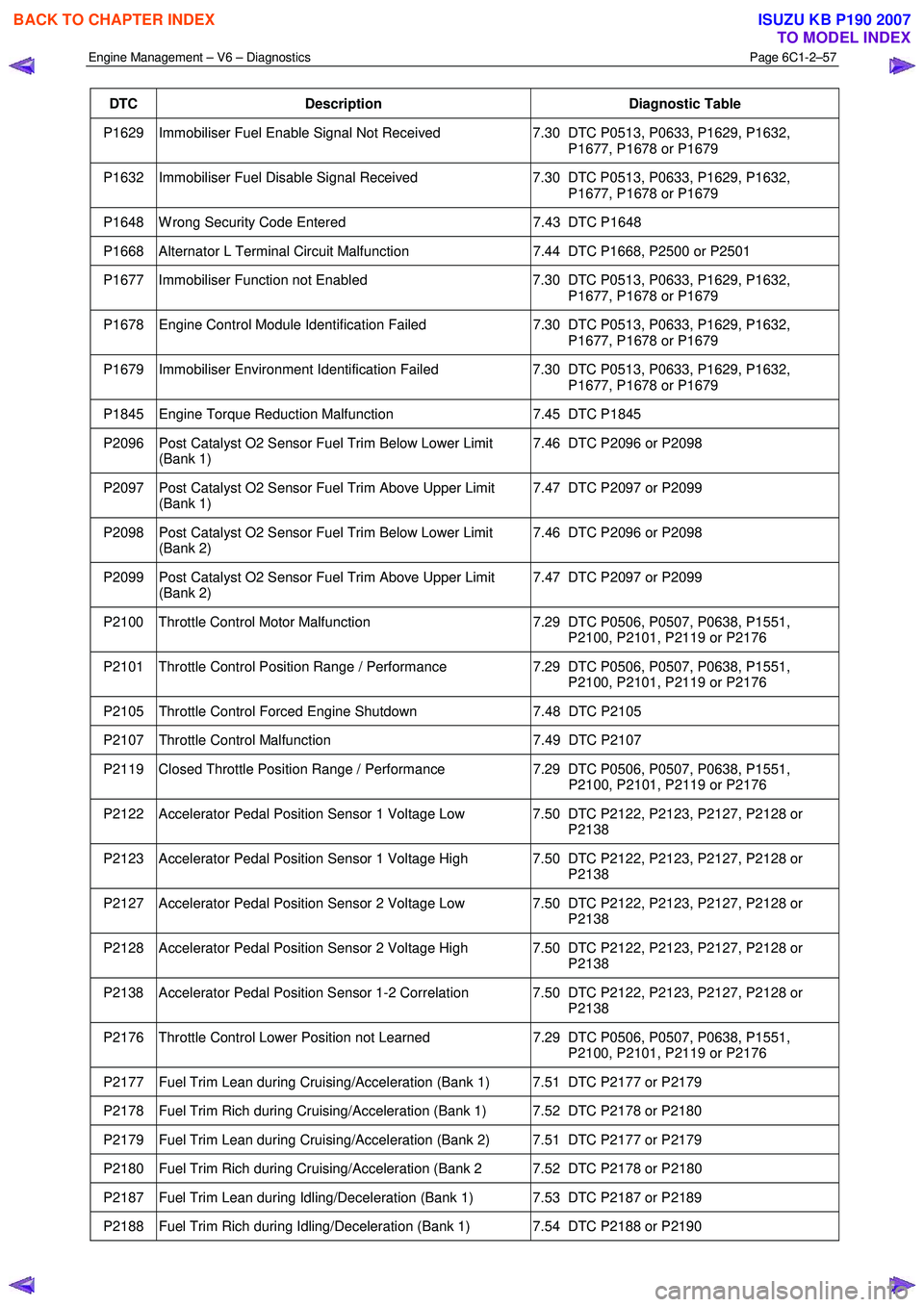
Engine Management – V6 – Diagnostics Page 6C1-2–57
DTC Description Diagnostic Table
P1629 Immobiliser Fuel Enable Signal Not Received 7.30 DTC P0513, P0633, P1629, P1632,
P1677, P1678 or P1679
P1632 Immobiliser Fuel Disable Signal Received 7.30 DTC P0513, P0633, P1629, P1632,
P1677, P1678 or P1679
P1648 W rong Security Code Entered 7.43 DTC P1648
P1668 Alternator L Terminal Circuit Malfunction 7.44 DTC P1668, P2500 or P2501
P1677 Immobiliser Function not Enabled 7.30 DTC P0513, P0633, P1629, P1632,
P1677, P1678 or P1679
P1678 Engine Control Module Identification Failed 7.30 DTC P0513, P0633, P1629, P1632,
P1677, P1678 or P1679
P1679 Immobiliser Environment Identification Failed 7.30 DTC P0513, P0633, P1629, P1632,
P1677, P1678 or P1679
P1845 Engine Torque Reduction Malfunction 7.45 DTC P1845
P2096 Post Catalyst O2 Sensor Fuel Trim Below Lower Limit
(Bank 1) 7.46 DTC P2096 or P2098
P2097 Post Catalyst O2 Sensor Fuel Trim Above Upper Limit
(Bank 1) 7.47 DTC P2097 or P2099
P2098 Post Catalyst O2 Sensor Fuel Trim Below Lower Limit
(Bank 2) 7.46 DTC P2096 or P2098
P2099 Post Catalyst O2 Sensor Fuel Trim Above Upper Limit
(Bank 2) 7.47 DTC P2097 or P2099
P2100 Throttle Control Motor Malfunction
7.29 DTC P0506, P0507, P0638, P1551,
P2100, P2101, P2119 or P2176
P2101 Throttle Control Position Range / Performance 7.29 DTC P0506, P0507, P0638, P1551,
P2100, P2101, P2119 or P2176
P2105 Throttle Control Forced Engine Shutdown 7.48 DTC P2105
P2107 Throttle Control Malfunction 7.49 DTC P2107
P2119 Closed Throttle Position Range / Performance 7.29 DTC P0506, P0507, P0638, P1551,
P2100, P2101, P2119 or P2176
P2122 Accelerator Pedal Position Sensor 1 Voltage Low 7.50 DTC P2122, P2123, P2127, P2128 or P2138
P2123 Accelerator Pedal Position Sensor 1 Voltage High 7.50 DTC P2122, P2123, P2127, P2128 or P2138
P2127 Accelerator Pedal Position Sensor 2 Voltage Low 7.50 DTC P2122, P2123, P2127, P2128 or P2138
P2128 Accelerator Pedal Position Sensor 2 Voltage High 7.50 DTC P2122, P2123, P2127, P2128 or P2138
P2138 Accelerator Pedal Position Sensor 1-2 Correlation 7.50 DTC P2122, P2123, P2127, P2128 or P2138
P2176 Throttle Control Lower Position not Learned 7.29 DTC P0506, P0507, P0638, P1551,
P2100, P2101, P2119 or P2176
P2177 Fuel Trim Lean during Cruising/Acceleration (Bank 1) 7.51 DTC P2177 or P2179
P2178 Fuel Trim Rich during Cruising/Acceleration (Bank 1) 7.52 DTC P2178 or P2180
P2179 Fuel Trim Lean during Cruising/Acceleration (Bank 2) 7.51 DTC P2177 or P2179
P2180 Fuel Trim Rich during Cruising/Acceleration (Bank 2 7.52 DTC P2178 or P2180
P2187 Fuel Trim Lean during Idling/Deceleration (Bank 1) 7.53 DTC P2187 or P2189
P2188 Fuel Trim Rich during Idling/Deceleration (Bank 1) 7.54 DTC P2188 or P2190
BACK TO CHAPTER INDEX
TO MODEL INDEX
ISUZU KB P190 2007
Page 3417 of 6020
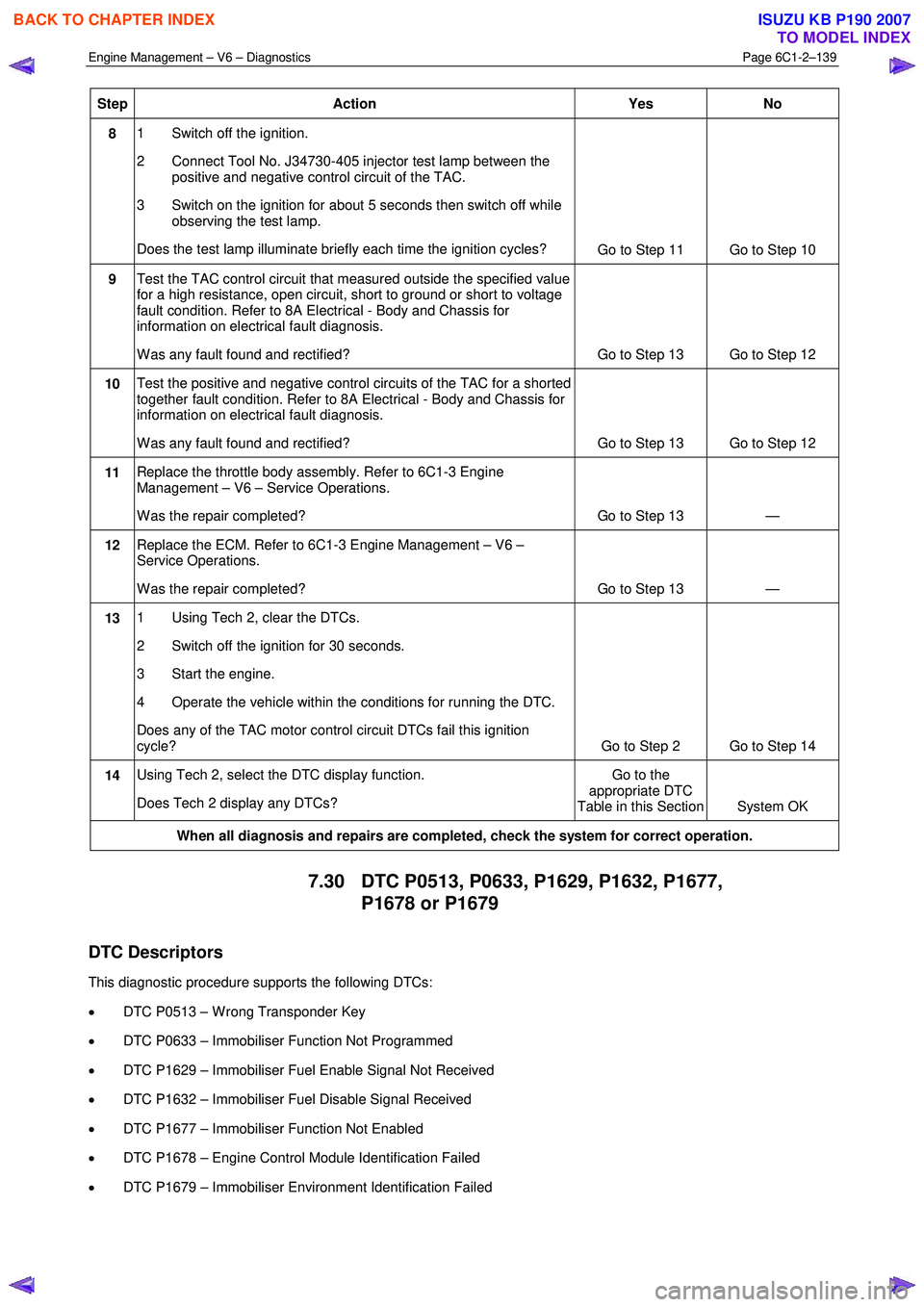
Engine Management – V6 – Diagnostics Page 6C1-2–139
Step Action Yes
No
8 1 Switch off the ignition.
2 Connect Tool No. J34730-405 injector test lamp between the positive and negative control circuit of the TAC.
3 Switch on the ignition for about 5 seconds then switch off while observing the test lamp.
Does the test lamp illuminate briefly each time the ignition cycles? Go to Step 11 Go to Step 10
9 Test the TAC control circuit that measured outside the specified value
for a high resistance, open circuit, short to ground or short to voltage
fault condition. Refer to 8A Electrical - Body and Chassis for
information on electrical fault diagnosis.
W as any fault found and rectified? Go to Step 13 Go to Step 12
10 Test the positive and negative control circuits of the TAC for a shorted
together fault condition. Refer to 8A Electrical - Body and Chassis for
information on electrical fault diagnosis.
W as any fault found and rectified? Go to Step 13 Go to Step 12
11 Replace the throttle body assembly. Refer to 6C1-3 Engine
Management – V6 – Service Operations.
W as the repair completed? Go to Step 13 —
12 Replace the ECM. Refer to 6C1-3 Engine Management – V6 –
Service Operations.
W as the repair completed? Go to Step 13 —
13 1 Using Tech 2, clear the DTCs.
2 Switch off the ignition for 30 seconds.
3 Start the engine.
4 Operate the vehicle within the conditions for running the DTC.
Does any of the TAC motor control circuit DTCs fail this ignition
cycle? Go to Step 2 Go to Step 14
14 Using Tech 2, select the DTC display function.
Does Tech 2 display any DTCs? Go to the
appropriate DTC
Table in this Section System OK
When all diagnosis and repairs are completed, check the system for correct operation.
7.30 DTC P0513, P0633, P1629, P1632, P1677,
P1678 or P1679
DTC Descriptors
This diagnostic procedure supports the following DTCs:
• DTC P0513 – W rong Transponder Key
• DTC P0633 – Immobiliser Function Not Programmed
• DTC P1629 – Immobiliser Fuel Enable Signal Not Received
• DTC P1632 – Immobiliser Fuel Disable Signal Received
• DTC P1677 – Immobiliser Function Not Enabled
• DTC P1678 – Engine Control Module Identification Failed
• DTC P1679 – Immobiliser Environment Identification Failed
BACK TO CHAPTER INDEX
TO MODEL INDEX
ISUZU KB P190 2007
Page 3418 of 6020
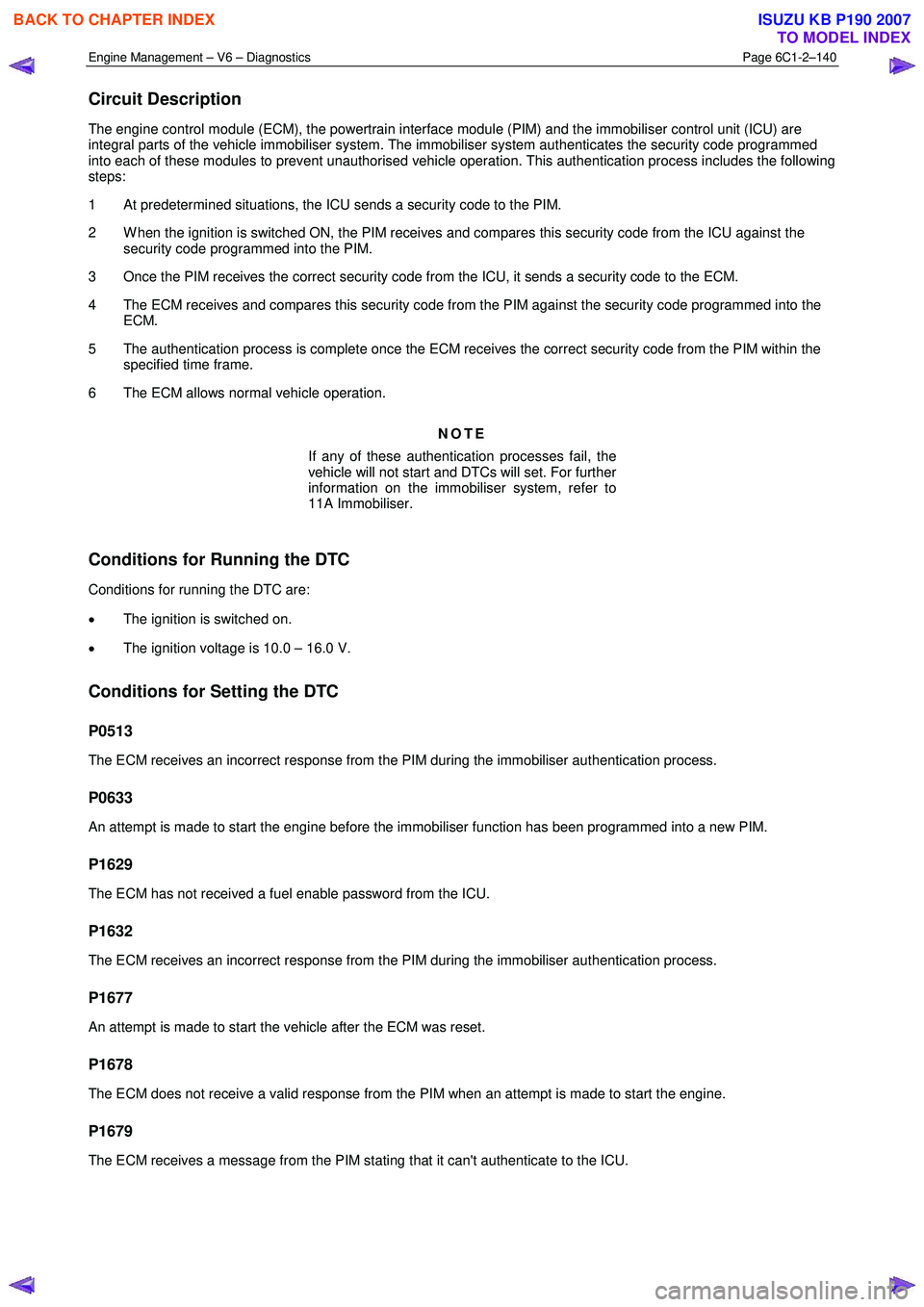
Engine Management – V6 – Diagnostics Page 6C1-2–140
Circuit Description
The engine control module (ECM), the powertrain interface module (PIM) and the immobiliser control unit (ICU) are
integral parts of the vehicle immobiliser system. The immobiliser system authenticates the security code programmed
into each of these modules to prevent unauthorised vehicle operation. This authentication process includes the following
steps:
1 At predetermined situations, the ICU sends a security code to the PIM.
2 W hen the ignition is switched ON, the PIM receives and compares this security code from the ICU against the security code programmed into the PIM.
3 Once the PIM receives the correct security code from the ICU, it sends a security code to the ECM.
4 The ECM receives and compares this security code from the PIM against the security code programmed into the ECM.
5 The authentication process is complete once the ECM receives the correct security code from the PIM within the specified time frame.
6 The ECM allows normal vehicle operation.
NOTE
If any of these authentication processes fail, the
vehicle will not start and DTCs will set. For further
information on the immobiliser system, refer to
11A Immobiliser.
Conditions for Running the DTC
Conditions for running the DTC are:
• The ignition is switched on.
• The ignition voltage is 10.0 – 16.0 V.
Conditions for Setting the DTC
P0513
The ECM receives an incorrect response from the PIM during the immobiliser authentication process.
P0633
An attempt is made to start the engine before the immobiliser function has been programmed into a new PIM.
P1629
The ECM has not received a fuel enable password from the ICU.
P1632
The ECM receives an incorrect response from the PIM during the immobiliser authentication process.
P1677
An attempt is made to start the vehicle after the ECM was reset.
P1678
The ECM does not receive a valid response from the PIM when an attempt is made to start the engine.
P1679
The ECM receives a message from the PIM stating that it can't authenticate to the ICU.
BACK TO CHAPTER INDEX
TO MODEL INDEX
ISUZU KB P190 2007
Page 3419 of 6020
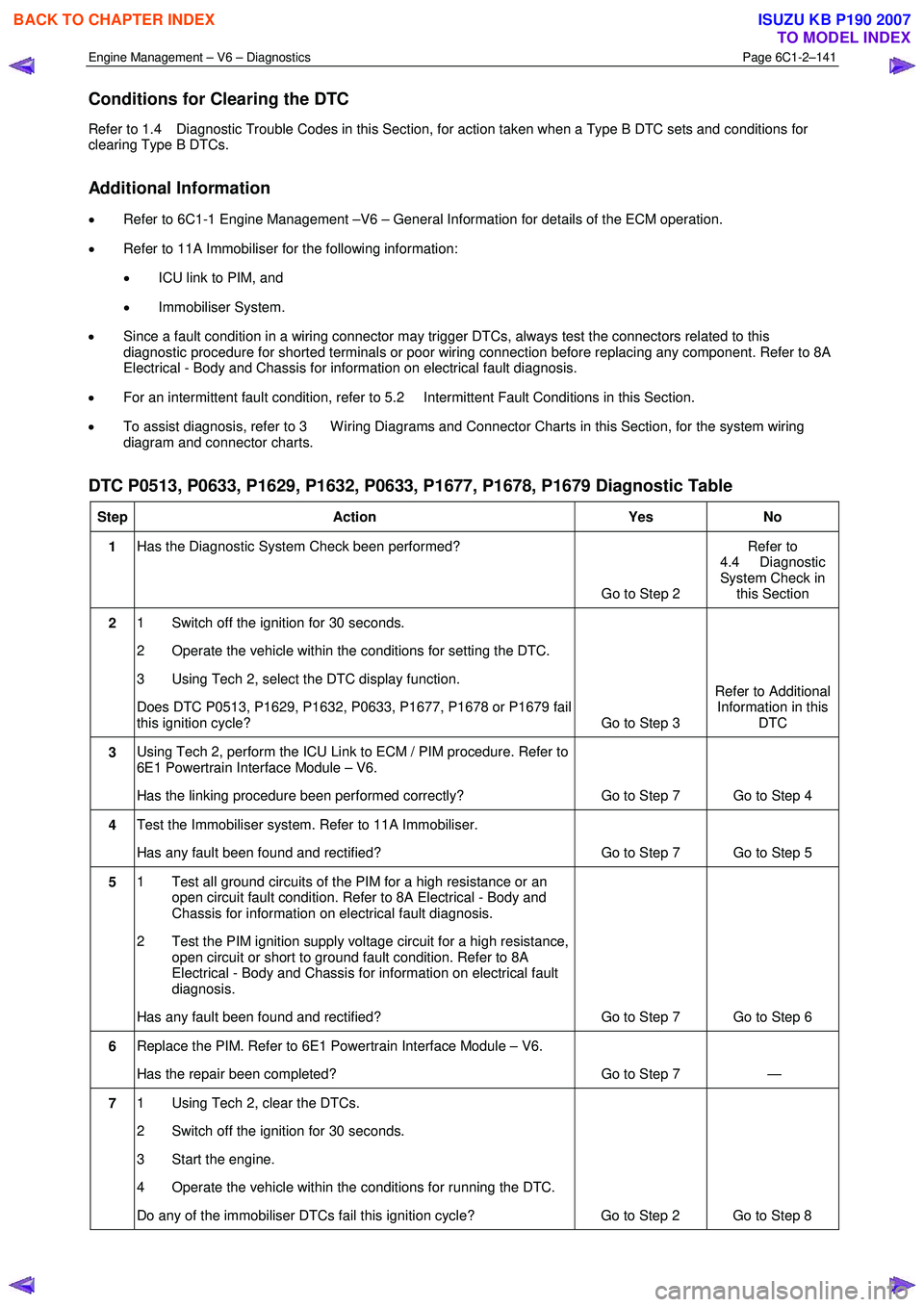
Engine Management – V6 – Diagnostics Page 6C1-2–141
Conditions for Clearing the DTC
Refer to 1.4 Diagnostic Trouble Codes in this Section, for action taken when a Type B DTC sets and conditions for
clearing Type B DTCs.
Additional Information
• Refer to 6C1-1 Engine Management –V6 – General Information for details of the ECM operation.
• Refer to 11A Immobiliser for the following information:
• ICU link to PIM, and
• Immobiliser System.
• Since a fault condition in a wiring connector may trigger DTCs, always test the connectors related to this
diagnostic procedure for shorted terminals or poor wiring connection before replacing any component. Refer to 8A
Electrical - Body and Chassis for information on electrical fault diagnosis.
• For an intermittent fault condition, refer to 5.2 Intermittent Fault Conditions in this Section.
• To assist diagnosis, refer to 3 W iring Diagrams and Connector Charts in this Section, for the system wiring
diagram and connector charts.
DTC P0513, P0633, P1629, P1632, P0633, P1677, P1678, P1679 Diagnostic Table
Step Action Yes No
1 Has the Diagnostic System Check been performed?
Go to Step 2 Refer to
4.4 Diagnostic
System Check in this Section
2 1 Switch off the ignition for 30 seconds.
2 Operate the vehicle within the conditions for setting the DTC.
3 Using Tech 2, select the DTC display function.
Does DTC P0513, P1629, P1632, P0633, P1677, P1678 or P1679 fail
this ignition cycle? Go to Step 3 Refer to Additional
Information in this DTC
3 Using Tech 2, perform the ICU Link to ECM / PIM procedure. Refer to
6E1 Powertrain Interface Module – V6.
Has the linking procedure been performed correctly? Go to Step 7 Go to Step 4
4 Test the Immobiliser system. Refer to 11A Immobiliser.
Has any fault been found and rectified? Go to Step 7 Go to Step 5
5 1 Test all ground circuits of the PIM for a high resistance or an
open circuit fault condition. Refer to 8A Electrical - Body and
Chassis for information on electrical fault diagnosis.
2 Test the PIM ignition supply voltage circuit for a high resistance, open circuit or short to ground fault condition. Refer to 8A
Electrical - Body and Chassis for information on electrical fault
diagnosis.
Has any fault been found and rectified? Go to Step 7 Go to Step 6
6 Replace the PIM. Refer to 6E1 Powertrain Interface Module – V6.
Has the repair been completed? Go to Step 7 —
7 1 Using Tech 2, clear the DTCs.
2 Switch off the ignition for 30 seconds.
3 Start the engine.
4 Operate the vehicle within the conditions for running the DTC.
Do any of the immobiliser DTCs fail this ignition cycle? Go to Step 2 Go to Step 8
BACK TO CHAPTER INDEX
TO MODEL INDEX
ISUZU KB P190 2007
Page 3429 of 6020
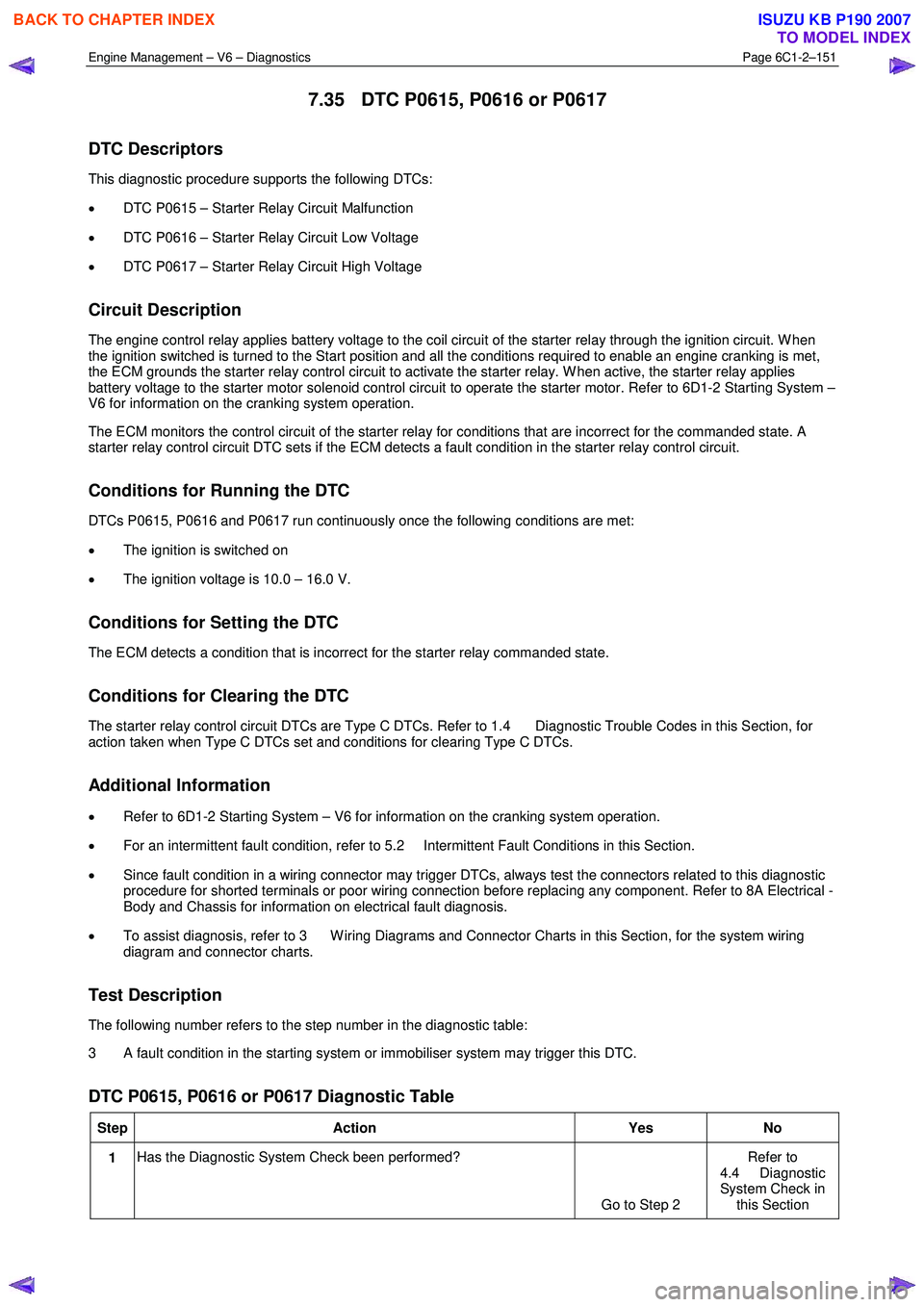
Engine Management – V6 – Diagnostics Page 6C1-2–151
7.35 DTC P0615, P0616 or P0617
DTC Descriptors
This diagnostic procedure supports the following DTCs:
• DTC P0615 – Starter Relay Circuit Malfunction
• DTC P0616 – Starter Relay Circuit Low Voltage
• DTC P0617 – Starter Relay Circuit High Voltage
Circuit Description
The engine control relay applies battery voltage to the coil circuit of the starter relay through the ignition circuit. W hen
the ignition switched is turned to the Start position and all the conditions required to enable an engine cranking is met,
the ECM grounds the starter relay control circuit to activate the starter relay. W hen active, the starter relay applies
battery voltage to the starter motor solenoid control circuit to operate the starter motor. Refer to 6D1-2 Starting System –
V6 for information on the cranking system operation.
The ECM monitors the control circuit of the starter relay for conditions that are incorrect for the commanded state. A
starter relay control circuit DTC sets if the ECM detects a fault condition in the starter relay control circuit.
Conditions for Running the DTC
DTCs P0615, P0616 and P0617 run continuously once the following conditions are met:
• The ignition is switched on
• The ignition voltage is 10.0 – 16.0 V.
Conditions for Setting the DTC
The ECM detects a condition that is incorrect for the starter relay commanded state.
Conditions for Clearing the DTC
The starter relay control circuit DTCs are Type C DTCs. Refer to 1.4 Diagnostic Trouble Codes in this Section, for
action taken when Type C DTCs set and conditions for clearing Type C DTCs.
Additional Information
• Refer to 6D1-2 Starting System – V6 for information on the cranking system operation.
• For an intermittent fault condition, refer to 5.2 Intermittent Fault Conditions in this Section.
• Since fault condition in a wiring connector may trigger DTCs, always test the connectors related to this diagnostic
procedure for shorted terminals or poor wiring connection before replacing any component. Refer to 8A Electrical -
Body and Chassis for information on electrical fault diagnosis.
• To assist diagnosis, refer to 3 W iring Diagrams and Connector Charts in this Section, for the system wiring
diagram and connector charts.
Test Description
The following number refers to the step number in the diagnostic table:
3 A fault condition in the starting system or immobiliser system may trigger this DTC.
DTC P0615, P0616 or P0617 Diagnostic Table
Step Action Yes No
1 Has the Diagnostic System Check been performed?
Go to Step 2 Refer to
4.4 Diagnostic
System Check in this Section
BACK TO CHAPTER INDEX
TO MODEL INDEX
ISUZU KB P190 2007
Page 3430 of 6020
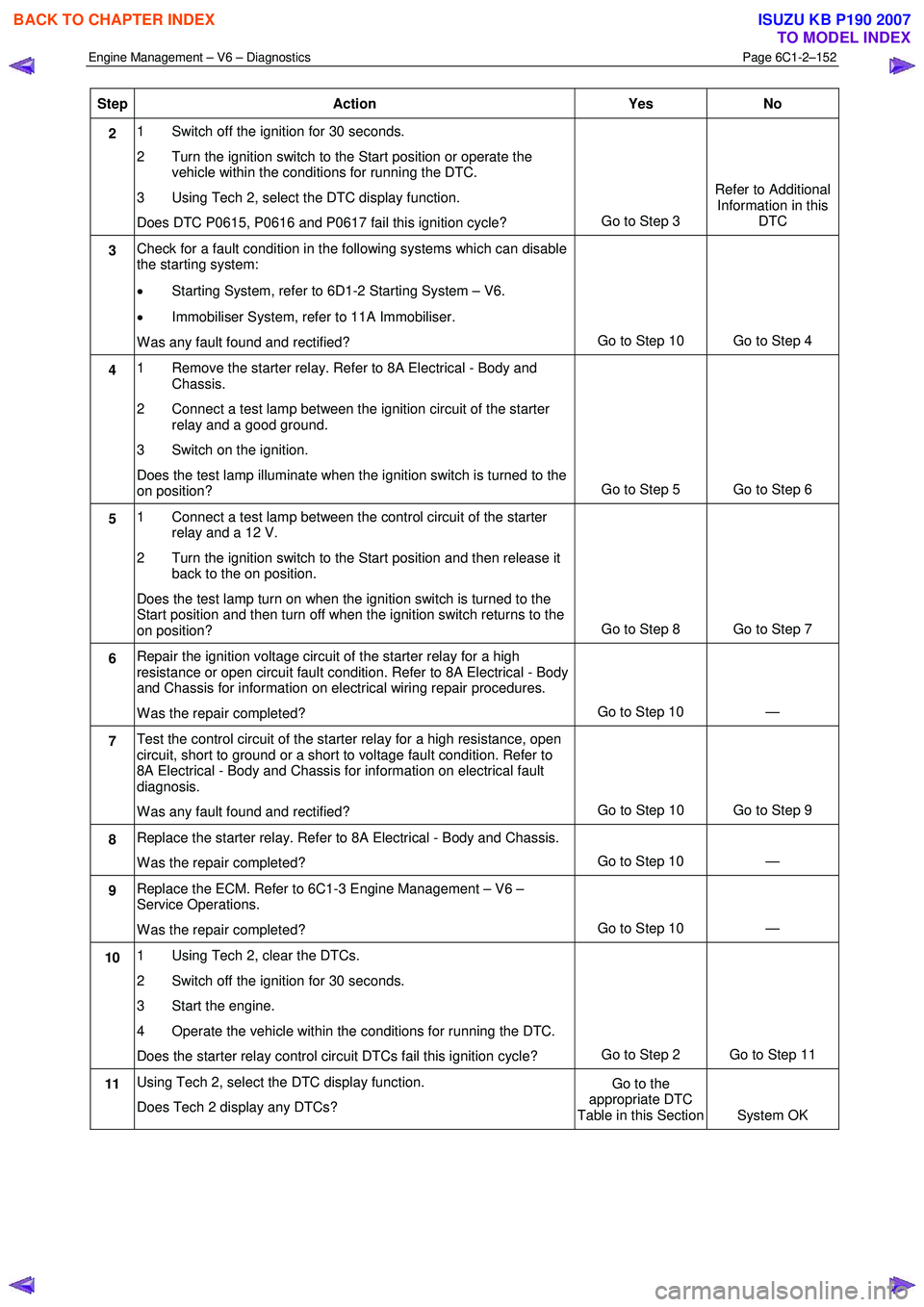
Engine Management – V6 – Diagnostics Page 6C1-2–152
Step Action Yes No
2 1 Switch off the ignition for 30 seconds.
2 Turn the ignition switch to the Start position or operate the vehicle within the conditions for running the DTC.
3 Using Tech 2, select the DTC display function.
Does DTC P0615, P0616 and P0617 fail this ignition cycle? Go to Step 3 Refer to Additional
Information in this DTC
3 Check for a fault condition in the following systems which can disable
the starting system:
• Starting System, refer to 6D1-2 Starting System – V6.
• Immobiliser System, refer to 11A Immobiliser.
W as any fault found and rectified? Go to Step 10 Go to Step 4
4 1 Remove the starter relay. Refer to 8A Electrical - Body and
Chassis.
2 Connect a test lamp between the ignition circuit of the starter relay and a good ground.
3 Switch on the ignition.
Does the test lamp illuminate when the ignition switch is turned to the
on position? Go to Step 5 Go to Step 6
5 1 Connect a test lamp between the control circuit of the starter
relay and a 12 V.
2 Turn the ignition switch to the Start position and then release it back to the on position.
Does the test lamp turn on when the ignition switch is turned to the
Start position and then turn off when the ignition switch returns to the
on position? Go to Step 8 Go to Step 7
6 Repair the ignition voltage circuit of the starter relay for a high
resistance or open circuit fault condition. Refer to 8A Electrical - Body
and Chassis for information on electrical wiring repair procedures.
W as the repair completed? Go to Step 10
—
7 Test the control circuit of the starter relay for a high resistance, open
circuit, short to ground or a short to voltage fault condition. Refer to
8A Electrical - Body and Chassis for information on electrical fault
diagnosis.
W as any fault found and rectified? Go to Step 10 Go to Step 9
8 Replace the starter relay. Refer to 8A Electrical - Body and Chassis.
W as the repair completed? Go to Step 10
—
9 Replace the ECM. Refer to 6C1-3 Engine Management – V6 –
Service Operations.
W as the repair completed? Go to Step 10
—
10 1 Using Tech 2, clear the DTCs.
2 Switch off the ignition for 30 seconds.
3 Start the engine.
4 Operate the vehicle within the conditions for running the DTC.
Does the starter relay control circuit DTCs fail this ignition cycle? Go to Step 2 Go to Step 11
11 Using Tech 2, select the DTC display function.
Does Tech 2 display any DTCs? Go to the
appropriate DTC
Table in this Section System OK
BACK TO CHAPTER INDEX
TO MODEL INDEX
ISUZU KB P190 2007